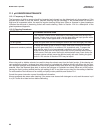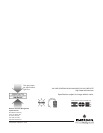
45
11.3.3 Checking the Reference Electrode.
Some processes contain substances, for example, sulfides, that poison the reference electrode. Poisoning alters the
electrode potential. For example, sulfide poisoning converts the reference electrode from a silver/silver chloride elec-
trode into a silver/silver sulfide electrode, causing a shift in potential of several hundred millivolts.
A good way to check for poisoning is to compare the voltage of the reference electrode with a silver/silver chloride
electrode that is known to be good. The reference electrode from a new sensor is the best choice. To check the sus-
pect electrode, place both sensors in a beaker containing buffer or a solution of potassium chloride. Connect the ref-
erence leads to a voltmeter and measure the potential difference. If the suspect electrode is good, the difference
should be no more than about 20 mV. Refer to Figure 11-1. A poisoned reference electrode usually requires replace-
ment.
A laboratory silver/silver chloride reference electrode can be used in place of the second sensor. All Rosemount
Analytical pH sensors have a silver/silver chloride reference, and most sensors use gelled saturated potassium chlo-
ride for the fill. The potentials of a good sensor reference electrode and a saturated silver/silver chloride laboratory
electrode will agree within about 20 mV.
11.3.4 Rejuvenating Reference Electrodes
Occasionally, a poisoned or plugged reference electrode can be reconditioned. Although the electrode seldom
recovers completely, the procedure might extend the life of the sensor by a few weeks.
1. Clean the sensor as thoroughly as possible.
2. Soak the sensor for several hours in a hot (NOT BOILING) 3% potassium chloride solution. Prepare the
solution by dissolving 3 g of potassium chloride in 100 mL of water.
3. Soak the sensor in pH 4 buffer at room temperature overnight.
4. Calibrate the sensor in buffers and retest it in the process liquid.
MODEL 6081-P pH/ORP SECTION 11.0
MAINTENANCE
FIGURE 11-1. Checking the Potential of the Reference Electrode.
Refer to the wiring diagram(s) for the sensors to identify the reference leads.


















